|
This is an electronic version of Kiernan, “The Conybeare-Madden Collation of Thorkelin’s Beowulf” in Anglo-Saxon Manuscripts and Their Heritage, edited by Phillip Pulsiano and Elaine Trehame. Aldershot, Hants, England and Brookfield, Vermont: Ashgate, 1997. 117-136. |
The Conybeare-Madden Collation of Thorkelin’s BeowulfIn 1817 John Josias Conybeare, Rawlinson Professor of Anglo-Saxon at Oxford University from 1808-1812, and Professor of Poetry thereafter, was presented with G.J. Thorkelin’s 1815 first edition of Beowulf by his brother, William. It may seem like a fine gift today, but by his own account it led John to three years of tedium between 1817-1821, when he arduously compiled the first detailed account of the Beowulf manuscript after the Thorkelin transcripts by collating the edition with the original manuscript in the British Museum. William paid more than once for the gift, moreover, for John Conybeare prepared selections from Beowulf and his long collation for the press by 1821, but then never got around to correcting all the proof sheets before his death in 1824. It was left for William to publish his brother’s Illustrations of Anglo-Saxon Poetry in 1826. Whitney F. Bolton brought ‘The Conybeare Copy of Thorkelin’ to our attention after he found the book in a Philadelphia bookstore and convincingly demonstrated in a preliminary analysis that, for the most accurate account of Conybeare’s readings, it was necessary to use it, rather than the posthumously published, and forever badly proofread, Illustrations.1 Recognizing that the book warranted a full-blown study to assess the value of the collation, Bolton mentioned in his article that he would ‘happily grant access to the Conybeare copy of [Thorkelin’s edition] to any qualified person who seeks it’.2 I borrowed the book in the early 1980’s and transcribed Conybeare’s collations for a planned diplomatic edition of Beowulf, but had to postpone these plans in 1984, after J.R. Hall discovered at Harvard University a more revealing collation (Houghton 28286.24.3*), evolving directly from Conybeare’s, by Sir Frederic Madden.3 After I transcribed the Madden collation in 1984, however, the advent of digital technology vitiated a diplomatic edition. Both of these collations are now part of the Electronic Beowulf image archive, giving scholars access in full-color facsimiles to both the first edition and the first revealing collations of the state of the Beowulf manuscript before the 1845 restoration binding both preserved and concealed the damaged edges.4 An intriguing relationship underlying the history of Conybeare’s collation flourished in the last six months of his life between Conybeare and the young Frederic Madden, who became an employee of the British Museum in 1828 and later was its long-time Keeper of Manuscripts (1837-66). According to Madden’s diary in Oxford Bodleian MS Eng. hist. C.145, Conybeare first struck up this friendship on Saturday, 17 January 1824, when he came for a visit, Madden says, ‘& asked me to accompany him into Bath, as like myself, from too sedentary a habit, he has been obliged to have recourse to the waters’ (38).5 Conybeare’s library, he discovered, housed ‘every volume in Saxon literature that had ever been published, except a few pages of a Saxon homily, which he had not got’ (41). One of the books he borrowed that first night was Elizabeth Elstob’s The Rudiments of Grammar for the English-Saxon Tongue (1715), the first Old English grammar written in English.6 He later recorded in his diary that he was determined to learn all he could about ‘the Saxon language’ from Conybeare, the former Professor of Anglo-Saxon at Oxford (49). Before the first day was done, Conybeare divulged that ‘he had been for some time engaged in completing for the press an abstract & specimens in blank verse of a very curious Saxon poem relative to the Danes, preserved among the Cotton MSS. and published in 4to. 1815. by Thorkelin’.7 He also told his new friend that day about his collation with the Beowulf manuscript, and even showed him ‘the numerous corrections he had made, not only of the Saxon, but of Thorkelin’s Latin translation’ (42-43). Although Madden does not say so in his journal, there is some reason to think that Conybeare might have tried to engage Madden at this time to proofread for him. Without such motivation it seems pointlessly self-deprecatory that Conybeare would at their first meeting admit that ‘he had sent his MS. to the press in 1821, but had not yet reviewed above eight proof sheets!’ Madden’s exclamation mark shows his own surprise at the disclosure. ‘This is a proof of Mr C’s indolence,’ he writes, ‘the only fault among all his merits, that is often observed’ (42-43).8 Madden’s strictures seem unfair. The year Madden met him, Conybeare delivered the Bampton lectures at Oxford and published a volume on the interpretation of Scripture; at about the same time he was publishing fairly widely on chemistry and geology; and he had earned a reputation for scrupulously attending to his clerical duties in Bath Easton. Why, then, would Conybeare open himself so quickly to Madden’s disapproval? Under the circumstances it is not too far-fetched to imagine that Conybeare, apparently busy with other wide-ranging projects, befriended Madden at this time for the express purpose of hiring him to undertake the proofreading for him. If this was Conybeare’s plan, it is less surprising to learn in the entry for 20 January 1824, three days after their first meeting, that Conybeare had actually given the uncorrected proof sheets to Madden. ‘In the evening I read over the proof sheets of the work Mr. C. has prepared for the press, and which he was good enough to lend me’, Madden writes in his journal. ‘All that has been printed amounts to 64 octavo pages, (it is to be published in this form, with a few copies in 4to. to bind up with Warton) and is entitled "Illustrations of AngloSaxon Poetry"’ (69). If he was not trying to enlist a reliable proofreader, it is puzzling that Conybeare should release the proof sheets to Madden at this time. Frustrating a conclusive investigation of this possibility, Madden by 1840 had completely replaced the section of his 1824 journal covering this acquaintance with Conybeare. On page viii of the extant version he wrote: Note. This journal for 1824 [i.e., from January] to 24th April was originally written in a volume of a smaller size than I had previously used, and was subsequently, at various times transcribed into the present volume. F.M. March, 1840 There are some overt cases in the new copy where Madden has done minor editing of the original journal, as when he repeatedly changes references from ‘Thorkelin’, which made sense in 1824, to ‘Beowulf’, which had become a recognizable name of the poem by 1840. Some relevant things had happened in the intervening years. Madden took a job in the Department of Manuscripts at the British Museum in 1828; Kemble published the first English edition of the poem using the title Beowulf in 1833;9 his second edition appeared in two volumes in 1835 and 1837; and Madden became Keeper of Manuscripts in 1837. Madden had a keen sense of his historical place in the British Museum, as his voluminous journals and seemingly endless notations in manuscripts clearly attest. Short of finding the original 1824 journal or related information in his or Conybeare’s papers, we can do no more than speculate about the curious circumstances surrounding Madden’s pre-publication access to Conybeare’s collations in both print and manuscript forms. We do know from his journal, however, that on 27 January 1824, ten days after learning about the ‘very curious Saxon poem’ at Conybeare’s house, Madden sent for his own copy of Thorkelin to help him learn Old English. He certainly had more ambitious plans for the volume, moreover, for he sent for an unbound copy, which he planned to ‘interleave, and add my own notes, and collate with the orig(ina)l MS.--Mr. Conybeare has done this already but I should not like to ask him for his copy’ (85). The next day, however, when he learned that Madden had sent for his own copy of Thorkelin, ‘Mr C. immediately offered to lend me his own copy, with permission to transcribe his MS notes and corrections, with his collation of the text with the Cotton. MS’. (87). What is going on here? First Conybeare gives Madden his proof sheets of the Illustrations, containing his uncorrected collation. Then he gives him his copy of Thorkelin’s Beowulf with the original collation, the essential source material he needs to proofread the uncorrected sheets. Are we to believe that Conybeare was more interested in giving Madden everything he needed to duplicate Conybeare’s collation than in proofreading and preparing for the press the Illustrations? It is far more credible that Madden in his 1840 replacement of the 1824 journal excised or revised some of the story behind Conybeare’s otherwise extraordinary behavior. There are other gaps and inconsistencies surrounding Madden’s use of Conybeare’s collation. On 31 January, Madden records that he had finished translating Edward Thwaites’s excerpt of George Hickes’s grammar,10 another book Conybeare loaned him, ‘and shall now pursue my study of Mr. C’s MSS. until the Beowulf arrives’ (96). In this context ‘Mr. C’s MSS.’ presumably refers to Conybeare’s manuscript notes, corrections, and collations from the interleaved copy of Thorkelin, which Conybeare had just given him permission to transcribe. But the situation is not so straightforward. We learn from the journal on 10 February that ‘The copy of Thorkelin’s Beowulf I sent for in sheets, is sold, so I have now ordered the bound copy from Bohn, at 1.4.0’. (110). It is surprising to find that Madden purchased a bound copy, because his own interleaved collation of Thorkelin survives in the Houghton Library at Harvard.11 This volume unequivocally shows that he went to the considerable trouble and expense of unbinding the new book, interleaving it, and rebinding it. Madden’s rebound interleaved copy includes a transcription of Conybeare’s collation as well as his own collation, which augments and corrects Conybeare’s work. There is convincing reason to believe, however, that the rebinding was done after he transcribed Conybeare’s notes and did the first phase of his own collation. In the first place, it is unlikely in the extreme that he was able to have the new copy interleaved and rebound in two weeks. Yet on 24 February he writes that ‘In the evening [I] began to copy Conybeare’s MS. notes from his interleaved copy of Beowulf, which he had sent’ (143). Moreover, he copied all of Conybeare’s collation and recorded most of his own on the printed pages, rather than on the interleaves. For Madden’s collations to be of any value, it is of course necessary to distinguish between his copy of Conybeare’s notes and his own independent observations of the state of the manuscript. Continuing the transcription in the evening of 27 February, Madden soon acknowledged to himself, at any rate, his large plans for Beowulf. ‘I should like much to publish a new edition with corrections’, he writes, ‘accompanied by an English version and Notes’ (145). These ambitions would explain why he had the edition interleaved sometime after he finished copying Conybeare’s collation and beginning his own. According to his diary, it takes him two weeks, from 24 February to 1 March, to finish transcribing Conybeare’s notes. On 3 March, he records, he ‘called on Mr Conybeare and returned Thorkelin’s Beowulf’ (146-147). Conybeare was not at home when he called, however, and we hear no more about Conybeare in Madden’s journals until Conybeare’s death in June. Madden learned of Conybeare’s death on 15 June 1824, according to the next volume of his journal in Oxford Bodleian MS Eng. hist. C.146 (30). Then he did not lose any time in pursuing his plans for an edition of Beowulf. Two days later at the British Museum he sends for the Beowulf manuscript, referring to it as Vespasian rather than Vitellius A. xv, but otherwise leaving no doubt that he was sending for Beowulf, ‘which I have not before had an opportunity of looking at’ (30).12 He begins his collation with the manuscript on 21 June 1824, less than a week after hearing of Conybeare’s death. ‘Notwithstanding Conybeare’s having gone three times over it’, Madden immediately observes, ‘he has omitted to notice a quantity of errors, & has added a few himself’ (32). 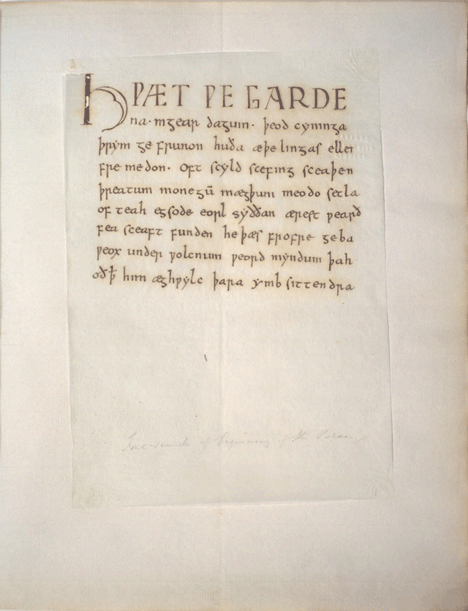
Two days later he mentions ‘tak[in]g facsimiles fr[o]m t[he] MS. of Beowulf, & ... continuing the collation of it’. One of these facsimiles is a careful tracing of the first page of Beowulf to line 9 recto, which is now the first page of Madden’s collation.13 He adds rather ruthlessly, ‘Now Conybeare is dead I am at perfect liberty to publish it in any way I please’, and goes on to imagine using ‘some such title as this. “Remains of metrical Romances, written in the Dano-Saxon dialect, and now for the first time published with an English transl[atio]n, copious illustrations, & critical observations. A literal Latin version is annexed”‘ (34). The next day, 24 June, he spent the whole day collating, and continues to disparage Conybeare’s collation. ‘There are a prodigious number of errors overlooked by Conybeare’, he says, ‘& even names spelt wrong, as AEgthreow, all through the poem, for Ecgthreow [sic], which he has not noticed!’ (34-35). His own misspelling of the name Ecgtheow may serve as fair warning to proud collators everywhere. When he finished his collating on 30 July, Madden boasts, ‘I completed today my collation of Beowulf, & what poor Conybeare called "Tædium trienne" has not occupied me (even at 1/2 an hour at a time) more than two months’. Mocking Conybeare’s ‘Tædium Trienne’, Madden copied the comment at the end of his own work and then added, ‘Tædium quator hebdomadum’. 
He goes on to say that ‘I am confident enough to assert that I have not overlooked a single letter, mark, erasure, or abbreviation, & have now the text precisely as it stands in the MS., which Conybeare, partly from haste, & want of care, & partly from not being able to read the MS. left in a very corrupt state, notwithstanding all his emendations of Thorkelin’s wretched transcript’ (59). Madden’s work is not perfect, needless to say. Even his careful tracing of the opening nine lines of the manuscript contains a d for an ð in weorð in line 8. There are, to be sure, many more mistakes and omissions in Conybeare’s collation. But there are as well some important details that Madden’s later work cannot supersede. Conybeare, for example, lets us know that two leaves in the Beowulf manuscript were still out of place when he collated, as he duly notes on the interleaves facing pages 9 and 61, for fol. 147A(131), and pages 197 and 231, for fol. 189A(197).14 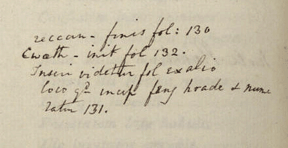
A striking example of the superiority of Madden’s collation over Conybeare’s can be seen in his restoration by facsimile of what appeared to be a lost reading from the edge of the manuscript. On folio 180r16 (verse line 2268), the crumbled edge now ends with the letters hwe. Thorkelin A recorded the meaningless form, hweir, whereas Thorkelin B by haplography unfortunately skipped over this section. In his edition Thorkelin therefore printed A’s hweir, which Conybeare in his collation accepted as the manuscript reading. Modern editors conjecturally restore the word as hwe(arf), on the paleographically sound assumption that the i was in fact a minim forming the ea ligature. At some stage in his collating Madden provided a facsimile on the interleaf that not only shows hwear but also a following descender, virtually confirming the editorial restoration. 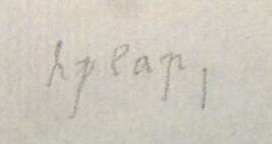
While Madden’s collation is undoubtedly much more accurate than Conybeare’s, it is not, as we have already seen, ‘the text precisely as it stands in the MS’. Its accuracy, moreover, was achieved in large part because it was done in the immediate context of Conybeare’s collation. Madden’s gloating at Conybeare’s expense seems particularly unseemly, in view of the special access he was given to Conybeare’s copy of Thorkelin and to the uncorrected proof sheets of his Illustrations of Anglo-Saxon Poetry. Even in the unlikely event that Conybeare did not expressly ask him to proofread for him, the question lingers why Madden, the quintessential collator with the relevant materials in hand, did not undertake the task out of friendship, reciprocity, curiosity, or duty. Instead, on 29 July 1826, when Conybeare’s brother William presents him with a copy of the posthumous book, Madden rather ironically dismisses it as ‘very faulty, as I have before had occasion to prove--but I have not got my own collated copy at hand, to point out the errors’ (460). An enduring value of Conybeare’s original collation in his copy of Thorkelin is that it shows, by Conybeare’s practice of under-pointing lost letters, the considerable amount of deterioration along the damaged edges of the manuscript in the time between the Thorkelin transcripts and his collation. By the same means Madden’s collation records further deterioration after Conybeare, and often shows in addition, as Madden rightly says, that letters Conybeare indicates were lost are in fact still there in the manuscript. Thinking that Hall’s comprehensive study of the collations was imminent in 1986, I confined myself to a few general remarks along these lines in The Thorkelin Transcripts of Beowulf: In his 1817 collation of the MS with Thorkelin’s 1815 first edition of the poem, J.J. Conybeare made dots beneath letters he could no longer see in the MS. By this testimony well over 900 letters Thorkelin records were gone from the edges by the time of the collation. However, the collation is not entirely reliable, for Conybeare failed to make dots beneath letters that are palpably conjectural restorations in Thorkelin’s edition. For example, both transcripts show that the bottom corner of 195r was gone when they were made (A has laðm and B has laðn for r20, both have gry for r21); yet in his edition Thorkelin reads laðne and gryre, and Conybeare passes over both conjectural restorations without marking them. A more accurate collation made by Sir Frederic Madden in 1824, recently discovered by J.R. Hall in the Houghton Library at Harvard, shows far more deterioration than Conybeare noted.15 With the facsimile one can see that Thorkelin in fact printed ‘laþ....’ (225), and that Conybeare in his collation added ne over the first two dots: 
Far from showing that Conybeare failed to mark a conjectural restoration by Thorkelin, the case shows Conybeare restoring a reading overlooked by both A and B. Following Conybeare, Madden in his copy of Thorkelin added the letters ne within the line, crossed out Thorkelin’s dots, and noted nulla lacuna. F[rederic]’. It appears, then, that a very shrunken e-head still survived at the edge of the vellum as late at 1824. At the same time, Madden underpointed the -re in gryre, showing simultaneous deterioration. While Conybeare’s collation is to some extent superseded by Madden’s more meticulous work, one cannot properly assess the evidential value of Madden’s collation without understanding its relation to Conybeare’s. The pivotal importance of these closely related collations can be usefully illustrated by reference to the readings in the damaged parts of the manuscript that are preserved by Thorkelin B alone. In The Thorkelin Transcripts of Beowulf (hereafter TTB), I came to the conclusion that it was often impossible to judge the authority of these readings in Thorkelin B, because of Thorkelin’s practice of editing, both as he transcribed and after he no longer had access to the manuscript. To illustrate the potential for uncertainty I listed a number of readings from the damaged edges where Thorkelin might have introduced intelligent editorial restorations, even if the manuscript was no longer intact. ‘Anyone with a rudimentary knowledge of Old English’, I argued, could have supplied the missing letters in wed(e)ra 139v1, (þ)a 140v6, (hw)ær 147A(131)v1, (h)is 147A(131)v3, hi(l)de 163r3, col(l)en169v4, (s)iððan 173v1, (on) ende 174v3, guð(um) 178r12, (o)n 178v8, (b)am 178v11, byrnend(e) 180r19, (win)trum 180v3, on (þære) westenne 181r2-3, meowla(n) 193r17, wundu(r) 195r14, and hæfd(e) 198r19.16 In fact, hi(l)de 163r3 does not really belong in this list. B is indeed the sole authority for l, but A records hib- (not hid-, as Zupitza says17), confirming that a letter survived at the edge of the manuscript. A’s reading actually helps confirm B, if we assume that A mistook the curved bottom of l, probably distorted by heat, for the bow of a b (or perhaps his b reflects a distorted l and bow of d). The sigla I use in the following entries are Thk with page numbers (e.g., Thk 10-11) for references to Thorkelin’s 1815 edition; A and B for the Thorkelin transcripts (1787 and c. 1790 respectively); CT for Conybeare’s collation in his interleaved copy of Thorkelin (c. 1817-1819, i.e., ‘trienne’); and MT for Madden’s collation in his interleaved copy of Thorkelin (1824, perhaps with later additions, especially on the interleaves). To facilitate reference to my collations in TTB, which the following notes augment and supersede, I use the same format, giving manuscript folio and verse lines, followed by the number of readings for which we are dependent on A or B. Round brackets show readings derived from A (often supported by B); square brackets distinguish 84 readings dependent on B alone. RESTORATION AND COLLATIONS REVISITED Fol. 132r/v, verse lines 113a-134b: (A 11, B 2): gi/[ga](nta)s r20-v1; Thk 11, ‘gigantas’. CT underlines, and writes ‘gi...is’, drawing a minim before s that looks like the right side of a. 
MT carefully copies Conybeare, and then later, using the manuscript, copies above it the remnant from the verso, this time with a much better caroline s. 
B’s excellent conjectural restoration is not based on the manuscript. Written in a much later hand, both the conjectural -[ga] and the -ntas v1, the latter confirmed by A, are on the wrong page in B, following gi- r20. 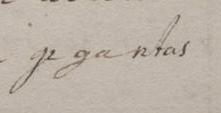
As this case illustrates, we must be doubly careful about accepting B’s readings, because Thorkelin’s conjectural restorations are sometimes extremely persuasive and almost certainly correct. CT treats the sequence gi...is as if it all came on the verso, while MT separates the letters with an open bracket where the page changes and places a ‘b’ in the margin to mark the verso. Fol. 139r, verse lines 401b-423a: (A 9, B 2): hea[rd] r2; Thk 33, ‘Heard’. CT accepts the whole word, but MT points d. A omitted by haplography r2-3 from heorotes (eye-skipping to heoðe in the next line). No reason to doubt B. Fol. 139v, verse lines 423a-444b: (A 10, B 1): (wed)[e]ra 1; Thk 34, ‘Wedera’. CT points the d, whereas MT points W (the w was apparently lost between A and B, because B added it later, presumably from A). A’s wedra is an attested variant spelling, but the fact that Madden points only W indicates that -ede- still existed when he collated and that B’s unsyncopated spelling is therefore correct.  
Fol. 140v, verse lines 464b-486a: (A 5, B 1): [þ]a 6; Thk 38, ‘þa’. CT accepts the whole word, but MT points þ. The agreement between AB is illusory, because A did not copy the line and B himself supplied it in A later. There is no reason to think that B wrote (as he often does) þ for ð, however, because the descender of what is presumably þ still survives.
Fol. 147A(131)v, verse lines 762b-782b: (A 9, B 3): [hw](ær) 1; Thk 59, ‘Hwær’. CT accepts the whole word, but MT points every letter and confirms the word was gone in his transcript facing pages 9-10, where he thought the misplaced leaf belonged. A has ...ær, leaving open other possibilities for conjectural restorations (e.g., ðær). 
[h]is 3; Thk 59, ‘his’. MT points h (and his transcription has ‘..s’). It may be an intelligent conjectural restoration in B; A omitted the word, perhaps because the h was already gone and the remainder obviously fragmentary. Fol. 148r, verse lines 827a-849a: (A 14, B 1): h[r..] 8; Thk 65, ‘hrægl’. CT and MT point ‘rægl’. hrof seems inevitable if B’s r is reliable. 
Fol. 151v, verse lines 986b-1009a: (A 2, B 1): [h]ilde 1; Thk 76, ‘hilde’. A skipped this word, because it was a dittographic error in the MS (see 151r20). MT writes in the word and notes that ‘Hilde is repeated’. Fol. 160v, verse lines 1377a-1398b: (A 6, B 1): Ecgþeo-[w]es 7-8; Thk 105, ‘AEgþeowes’. CT accepts the spelling (including the AE for Ec), whereas MT crosses out ‘AE’ and writes ‘ec’. Forms without w are attested for both Ecgþeow and Ongenþeow, but not in the first scribe’s part of the MS. B’s w may be an easy conjectural restoration of a proper name, but there is no reason to reject his restoration. Fol. 161v, verse lines 1423-1448a: (A 17, B 1): [f...] 2; Thk 108, ‘fughton’. CT and MT cross out g and point the rest of the word. Given its position, f is likely to be a conjecture, based on the alliteration. Fol. 169v, verse lines 1802b-1826a: (A 33, B 5 or 7): [ða c]om or perhaps [ða com] 1; Thk 136, ‘Coman’ (abandoning B). CT and MT point the whole word. Faint traces of what appear to be -om (B) or -m remain on an angle of the vellum, but there is room for continued conjecture, too. [f](ar)ene 3; Thk 136, ‘farene’. Both CT and MT point fa, but there is no obvious reason to doubt B here. col-[l](en)-(f)erhð 3-4; Thk 136, ‘collen ferþ’. CT and MT point len. MT provides a corroborating transcript, ‘cuma col.... ferhð sic MS’. But there is no evident reason to doubt B’s l. 
Fol. 173v, verse lines 1978b-1999: (B 1): [s]yððan 1: the UV image shows that the letters before ððan were high-s and y, not uncial s and i, as I still thought when this article went to press (cf. Iððan A; B’s later sy was formerly i). (M76.2: sy partly gone, partly covered, partly visible.) Fiber-optic backlighting indicates that sy is virtually intact.18 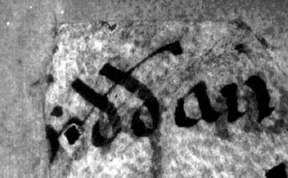
Fol. 174r, verse lines 2000-2019a: (A 20, B 6): hige[lac] 1; Thk 150, ‘Higelac’. CT and MT point lac, which B wrote in later over dots. A leaves a space here. B most likely made a conjectural restoration, based on his knowledge of the proper name, Higelac. There are other possibilities, such as the adjective higerof, ‘brave-minded’, which also fits the context (’lord Higelac’ or ‘brave-minded lord’). hwy(l)[ce..](...) 2; Thk 150, ‘hwylce / ........’ (A hwyle, followed by a blank space; B hwylce..). CT and MT add two dots after hwylce and CT crosses out Thk’s line of dots and writes ‘nihil deficit’. Disagreeing, MT later writes on or or (copying an insular r, if so) on these dots and notes, ‘Forte litera des[un]t. F’. Modern editors, following Thorpe, conjecture that five letters, orleg-, were lost after hwylc, an emendation of both A and B. 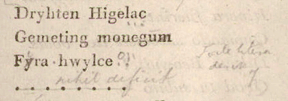
(fæ)[r] 9; Thk 151, ‘Fær’ (A fæ..., B fer..). CT and MT point the whole word.19 There is room and reason for other conjectures. 
Fol. 174v, verse lines 2019a-2041b: (A 20, B 3): [...u](gu)ðe 2; Thk 151, ‘guþe’ (rejecting B). Ignoring þ for ð, both CT and MT accept Thk’s emendation of B, strongly suggesting that the first u as well as what was presumably a d were then gone. [on] 3; Thk 152, ‘on’. CT accepts the whole word, but MT points o. B may have provided an intelligent conjectural restoration; A first wrote what looks like an e, apparently beginning to write ende, the next word in the line, but then smudged out the letter and left a blank before ende. Fol. 175r, verse lines 2041b-2062a: (A 28, B 8): g(e)[nam] 1; Thk 153, ‘genam’. CT points nam, and writes in the margin, ‘vid./ m. u nu/’. MT writes, ‘mi MS. It is mi or nu. F. I think t[he] latter’. B changed ge m. to genam. later. gri(m)[me] 2; Thk 153, ‘grim ...’. CT and MT accept the fragmentary reading. B added me later, apparently as a conjectural restoration. 20 Here and elsewhere, Thorkelin treats B as an unreliable witness. mec(e) [c] 6; Thk 153, ‘mece’. CT accepts the whole word, but MT points second e. B’s lonely c is presumably an error, the start of g from the beginning of the next line. Once again, Thorkelin ignores the testimony of B. Fol. 177r, verse lines 2127b-2146b: (A 22, B 7): fæð[rungu] 1; Thk 159, ‘fædrunga / þær under’ (þær un- a conjectural restoration linking the end of line 1 with the following -der r2). CT and MT both point -unga / þær un-. B’s ungu were written later on original dots and are probably spurious.21 The final letter in B is u, not a (the top is open, at any rate). 
hroðg[ar..] 2; Thk ‘Hroþgare’. CT accepts the whole word, but MT points are. It is possible that the edge of the manuscript was already gone, and B simply restored the proper name. Thorkelin in his edition supplied a dative ending, which all editors accept, but a genitive is another possibility.22 Fol. 178r, verse lines 2166b-2185: (A 34, B 6): re[n...] 2; Thk 162, Deaþre. CT and MT accept, seeing nothing following re. The n in B was written in another ink, and without any corroboration from A is to that extent suspect. Thorkelin himself rejected it in his edition. (b)[eal]dode 11-12, Thk 163 beal dode. CT and MT point eal, which B wrote later. If they are conjectural, B provides an excellent restoration. gu(ð)[um] 12; Thk 163, ‘gudum’. CT and MT point dum, but MT also crosses d to ð, leaving it uncertain whether or not the letter was still there. Assuming the reading is authentic, it is likely that B expanded the u-macron abbreviation to um. Fol. 178v, verse lines 2186-2207a: (A 22, B 5): [dri]hten 1; Thk 163, ‘Drihten’. CT and MT both point Dri. 
B added these letters and altered an original n to h. much later with a shaky hand and a different ink, when he no longer had access to the manuscript. 
I have elsewhere used this reading as an instance of how Thorkelin sometimes makes B an edition-in-progress, rather than an objective transcription.23 If one is trying to determine the state of the manuscript when he copied, his practice of editing while transcribing is especially dangerous, because his conjectural restorations, as in this case, are sometimes almost certainly right, except for the spelling. It is presumably for this reason that in his edition Thk frequently accords more authority to A than to B, his own transcript. As I point out in TTB, elsewhere the second scribe invariably uses the spelling dryhten, not drihten. [o](n) 8; Thk 164, ‘On’. CT accepts the whole word, but MT points On. A .n, B on; even without B, on would remain an inevitable restoration in the context. Dependence on B is for o (TTB, 145), not on (TTB, 80). [b](a)m 11; Thk 164, ‘bam’. CT points ba, MT only b. If b was also gone when B copied, as his original reading ..m suggests, he would have been able to make the later conjectural restoration with ...am (confirmed by A) and the following samod. Fol. 180r, verse lines 2252b-2274: (A 19, B 1): byrnend[e] 19; Thk 170, no reading (following A, who commits a haplographic error). CT notes on the facing interleaf, ‘opene standun fethe byrnende beorgas seceð omissa apud Thorkelin’. Thus CT independently corroborates B, who knew enough Old English to supply the e with or without the manuscript. MT copies CT, correcting standun to standan, fethe to sethe, and beorgas to biorgas. It is remarkable that Thorkelin gives more authority to A than to B here. Fol. 180v, verse lines 2275-2296a: (A 11, B 8): [bearn] 1; Thk 170, ‘bearn’. CT accepts the whole word, while MT points every letter. The vestiges support B and CT, but the alliterative pattern suggests h for b (perhaps hearm, ‘injury, harm’). Zupitza’s restoration, hord, is not supported by the spacing or the traces, but all modern editors accept it. [win]trum 3; Thk 170, ‘wintrum’. CT accepts the whole word, but MT points win. Madden comments on the first three lines, ‘the whole of these lines nearly obliterated’, but beside Thk’s ‘Hic lacuna incidit, qvæ XV versibus respondet absentibus’, he says, ‘nulla lacuna except[in]g 3 illeg[ible] letters want[in]g’.24 For the last two fairly legible words, ðy sel, which B omitted, Madden (belying his claim that everything is precisely as it stands in the manuscript) has ðl læ.?. 
[Conybeare] 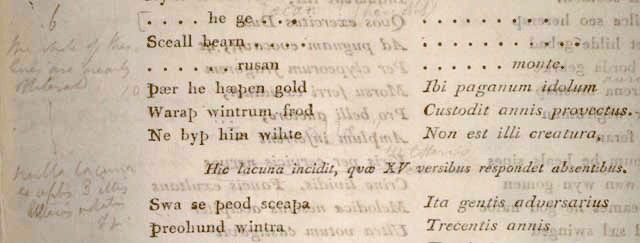
[Madden] Fol. 181r, verse lines 2296-2315b: (A 25, B 4): [þære] 2; Thk 171, ‘þære’. CT accepts the whole word, but MT points ære. Although some of the left side of the bow and the descender of what B says is þ remains, there is not enough to confirm þ over (say) wynn or f. Moreover, B’s feminine demonstrative þære is apparently a conjectural restoration, which most modern editors have accepted as authoritative. The expected form in poetry with following westenne is þam.25 Fol. 182v, verse lines 2361b-2384a: (A 9, B 2): [.on] 3, Thk 176, omits (following A rather than B). CT writes an ellipsis of three dots, MT three dots followed by n. No apparent reason to question B here. Fol. 189A(197)r, verse lines 2655b-2681: (A 34, B 3): nio(s)[nan] 13; Thk 199, ‘niosnian’. CT and MT both point snian. B has nan on dots, and may be based on A. With square-topped a, the sequence of minims in mosum (A) resolves to the presumed correct form, niosian. Fol. 189r, verse lines 2705a-2731a: (A 27, B 1): beal(onið)[i] 8; Thk 202, ‘Bealo nið’ (cf. A nið). CT accepts the whole word, but MT puts a point after it and notes, ‘a letter gone after nith. F[rederic]’. Thus MT supports B where Thorkelin does not. The minim B records may be the left side of the e editors conjecturally restore. Fol. 193r, verse lines 2909b-2937a: (A 24, B 1): meowl(a)[n] 17, Thk 217, ‘meowla’ (following A). CT and MT point a, note ‘ita M[S]’. The left side of a remains on the edge of the vellum. There is no reason to doubt B’s reading. Fol. 194r, verse lines 2964a-2990a: (A 2, B 1): he[d..] 20, Thk 221, ‘............./....’ (following A). CT crosses out the first line of dots, and supplies he on the first two dots of the second line. MT copies CT, but also adds in the line what remained of the ascender of d; later, when the book was interleaved, he made a facsimile on the facing page by copying MS bær he and the top of d or ð, as in the MS now, except for bottom of e. The height of the ascender indicates that B miscopied d for ð, but there is no vestige of a hair-stroke. Fol. 195r, verse lines 3015b-3041a: (B 1): wundu[r] 14; Thk 225, ‘Wundur’. CT accepts the whole word, but MT points r, more than half of which still survives on the edge. The fact that A omits the r suggests that it was already fragmentary and that B conjecturally restored it. Fol. 198r, verse lines 3121b-3150a: (A 13, B 7): [syfone] 1; Thk 231, ‘Syf one’. CT points one, as does MT; Madden later (judging by the different types of underdotting) indicates that syf was also gone, but much of it can still be pieced together. 
In fact, after the book was interleaved, Madden provided a detailed facsimile on the interleaf, which shows, corroborating B and the MS now, what appears to be the top and bottom of high s and the bottom of f. His facsimile also shows the top of s in somne, the next word. 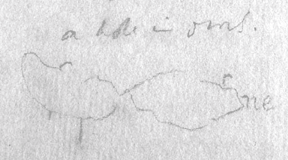
hæfd[e] 19; Thk 233, ‘hæfde’. A omits the e and B adds it later, opening the possibility that it was gone when B copied, and that it may be his conjectural restoration. CT does not underpoint the e, but MT does. Fol. 198v, verse lines 3150b-3182: (A 11, B 4): [bi]ð 17; Thk 235, ‘biþ’. CT and MT point bi, but MT provides a facsimile on facing interleaf that shows the tops of b and i still visible in the MS. 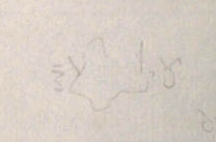
freog[en] 18, Thk 235, ‘freo gen’. CT accepts the whole word, but MT corrects gen to the g-macron abbreviation for ge. The faulty expansion in B is a typical feature of his edition-in-progress. |
Notes1. English Studies 55 (1974), 97-107. The colophons are on page 236 and the facing leaf. In the colophons Conybeare makes clear that he started the collation in 1817 and continued the work in 1818 and 1819. When he finished collating, he wrote ‘Tædium Trienne. C.’ on the last page. 2. Ibid., p. 98. 3. Hall is preparing a comprehensive study of nineteenth-century collations, Early Scholars and the Beowulf Manuscript, which he expects to complete by the year 2000. 4. When asked if we might digitize the Conybeare collation for the Electronic Beowulf in 1994, Whitney Bolton promptly donated the book to the British Library to expedite our work. The Houghton Library at Harvard allowed us to begin digitizing the Madden collation in 1994, and to bring the British Library camera to Harvard in 1996 to complete the work. All of these materials will be published on CD-ROM in 1997 by British Library Publications and the University of Michigan Press. 5. For the first extensive discussion using these diaries, see Robert W. and Gretchen P. Ackerman, Sir Frederic Madden: A Biographical Sketch and Bibliography (New York: Garland, 1979). The entire collection is listed there as Diary of Sir Frederic Madden, 1819-73, 43 vols., Bod. MSS. Engl hist. c. 140-82 (73). 6. (44). English Linguistics, 1500-1800 (A Collection of Facsimile Reprints) no. 57 (Menston, England: Scolar Press, 1968). 7. After the poem was given its now customary name, Madden inserted Beowulf preceding ‘a very curious Saxon poem relative to the Danes’ (42). His changes to his original journal in the surviving 1840 version are further discussed below. 8. Primary sources of his biography in the Dictionary of National Biography 4, are the Royal Society’s Catalogue of Scientific Papers and the Geological Society’s Transactions (986). For other short accounts of Conybeare, see Hans Aarsleff, The Study of Language in England (Princeton, 1967), 175-176; and Georgian R. Tashjian, ‘Richard Rawlinson and the Anglo-Saxon Professorship at Oxford’, in Georgian R. Tashjian, et al., Richard Rawlinson: A Tercentenary Memorial (Kalamazoo, MI: New Issues Press, Western Michigan University, 1990), 83-98. 9. John M. Kemble, ed., The Anglo-Saxon Poems of Beowulf, The Travellers Song, and the Battle of Finnes-burh (London, 1833). 10. Grammatica Anglo-Saxonica, ex Hickesiano Thesauro Excerpta (1711), English Linguistics, 1500-1800 (A Collection of Facsimile Reprints) no. 256 (Menston, England: Scolar Press, 1970). The journal shows that Madden began translating on 21 January. Hall has found this translation, too, in the Medlicott Collection. See ‘William G. Medlicott (1816-1883): An American Book Collector and His Collection’, Harvard Library Bulletin n.s. 1.1 (1990), 13-46, at p. 39. 11. See J.R. Hall, ‘Some Additional Books at Harvard Annotated by Sir Frederic Madden’, Notes and Queries 32 (1985) 313-315. 12. Here, and the next day, when he made a detailed description of the manuscript, Madden refers to it as Vespasian A. xv, instead of Vitellius A. xv. See Kiernan, ‘Madden, Thorkelin, and MS Vitellius/Vespasian A XV’, The Library, sixth series, 8.2 (1986), 127-132. 13. Other facsimiles, meticulous drawings rather than tracings, survive on the interleaves, as illustrated below. There may be other tracings among Madden’s papers. They would be worth looking for, judging by the one that we have now. 14. See Kiernan, Beowulf and the Beowulf Manuscript, 2nd ed. (University of Michigan Press, 1996), pp. 137-138 n. 47. 15. The Thorkelin Transcripts of Beowulf, Anglistica 25 (Copenhagen: Rosenkilde and Bagger, 1986), p. 150 n. 46. 16. Ibid., p. 145. 17. Julius Zupitza, Beowulf: Reproduced in Facsimile from the Unique Manuscript British Museum MS. Cotton Vitellius A. xv, with a transliteration and notes, Early English Text Society, o.s., 77 (London: Oxford University Press, 1882); 2nd ed. containing a new reproduction of the manuscript with an introductory note by Norman Davis, Early English Text Society, o.s., 245 (London: Oxford University Press, 1959; repr. 1967. 18. My previous, erroneous decription was, "Thk 149, ‘Iþþan’ (based on A’s ..iððan, rather than B’s syððan). CT and MT have ‘..Iþþan’, but CT writes ‘/Syð. Q[uære]?’ in the margin, and MT similarly notes ‘yððan MS. evidently syththan. F’. The remaining traces, however, support A: CT and MT mistake, in my opinion, the vestiges of uncial s (cf. s in secean v11) for the dot and left side of y, and the i (disfigured by a tiny hole) for the hair-stroke of y. B’s syððan is an intelligent conjectural restoration." 19. Fr. Klaeber emends to f(acne) and credits Kemble, rather than Thorkelin, for fær. Beowulf and the Fight at Finnsburg, 3rd edition (Boston: D.C. Heath and Company, 1950), 75 note. 20. The grim sefa of the editions, emending me to se and combining it with fa in the next line, should be regarded as a conjectural restoration, based solely on Kemble, who freely changed manuscript readings even in his collation. 21. See my discussion of later readings on dots on p. 138: ‘...when dots are written over, it may only mean that Thorkelin ... later made a conjectural restoration of a reading lost before he copied the manuscript’. I did not attempt to treat this uncertain area exhaustively, as I say: ‘A few examples of his use of dots will show how unreliable they can be’. 22. In TTB I mistakenly give hroðg(are) instead of hroðg(ar) as the possibly restored reading (78, 145); B‘s reading appears correctly as Hrodgar.. in the collations (79). 23. Ibid., p. 144. 24. Here Thorkelin again accords more trust and greater authority to A than to his own transcript. Faced with their deliberate erasure, A left lines 1-3 blank, whereas B tried to transcribe them. 25. See TTB (145); George Jack mistakenly changes þam to þæm, a spelling the second scribe never uses; see ‘Beowulf’. A Student Edition (New York: Oxford University Press, 1994), line 2298 note. J. R. Hall discusses the reading at length in ‘Beowulf 2298a: on þ[ã] westenne?’, Notes and Queries 43.3 (1996), 254-257. I am grateful to Hall for carefully reading a draft of this essay and helping me avoid some mistakes and clarify some possible misunderstandings. |